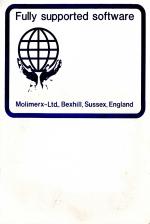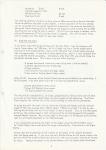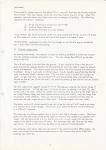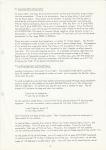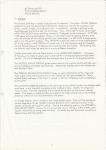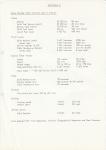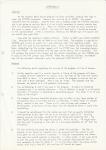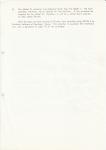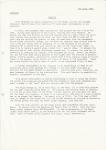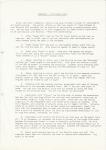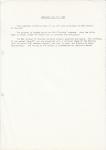| Genre: | Unknown Genre Type |
| Publisher: | Molimerx |
| Cover Art Language: | English |
| Machine Compatibility: | BBC Model B |
| Release: | Professionally released on Cassette |
| Available For: | BBC Model B |
| Compatible Emulators: | BeebEm (PC (Windows)) PcBBC (PC (MS-DOS)) Model B Emulator (PC (Windows)) |
| Original Release Date: | 17th July 1984 |
| Original Release Price: | Unknown |
| Market Valuation: | £2.50 (How Is This Calculated?) |
| Item Weight: | 64g |
| Box Type: | Cassette Single Plastic Clear |
| Author(s): | J. E. Midwinter |
Variant Items
There are 0 other items featuring this same game (that we know about!). Click any of them for their details.
Active Auctions
Closed Auctions
Buy It
Unfortunately no-one is currently selling this item.
Auction Price Watch
Worried you're being ripped off? Closing prices on eBay can help you decide what a reasonable price is for a particular item.
Full Instructions
1. Introduction
This program models the flight of the Space Shuttle. lt operates in "real time", which means that each stage takes roughly the same time as it would for the real vehicle. Since a full flight, from take-off, into orbit and back through re-entry to landing takes a long time, the program is written so that you can fly each stage separately, starting on the ground just before blast-off, in orbit or just before re-entry during the landing phase. You are presented with this choice immediately after loading the program. You are also asked whether you wish to work in metric or Imperial units, the default values being Imperial.
At blast-off, the major thrust is provided by the two solid fuel rockets, aided by the Shuttles own engines. After about 120 seconds, the solid fuel is exhausted and the rocket shells jettison automatically. The flight continues under the power of the Shuttles motors using fuel from the huge tank attached, into orbit. When the fuel is exhausted, the empty tank is also jettisoned. Once in orbit, manoeuvres can be carried out using the orbital manoeuvre engines which also are used to slow the Shuttle so that it drops out of orbit. The final re-entry and landing phases are unpowered with the vehicle acting as a glider.
During the initial blast-off, the shuttle engines can fail (fortunately very occasionally). If this occurs, then you must land without entering orbit. Once in orbit, you can rendezvous with an orbiting satellite if you are a skilled pilot and on landing, apart from just landing within the right speed window, you can try and land back at the airbase you started from. When you can do all these things, you should apply to NASA for a job as an Astronaut since you are getting good!
We will now discuss the various phases of the flight in more detail. For information on the controls available to you, see the checklist at the end of the program notes. You may find it helpful to keep this by you when flying until you are familiar with the controls.
Once flying, you can buy yourself some THINKING TIME by KEYING V for Video Display Menu. This allows you to select another display format, but also stops the program until you have made your selection. This is the one concession made to you as a Trainee Astronaut!
2. General information On Flying The Shuttle
The Space Shuttle has three main propulsion systems. There are two huge solid fuel rockets that burn for about 120 seconds after Blast-Off and then jettison their shells automatically. These provide the major boost to lift the vehicle off the ground. Then there are the three motors mounted in the tail of the Shuttle which are fuelled by liquid fuel from the huge tank to which the vehicle is attached. These provide the additional boost to lift the vehicle into orbit. The tank must be jettisoned once the engines have done their task, after which they remain dead. Finally, there is the Orbital Manoeuvre Engine which is only used for manoeuvre within orbit. It generates a great deal less thrust than the Shuttles main motors but it is sufficient to allow the vehicle to leave orbit and for simple orbital rendezvous exercises.
Small thruster rockets on board the vehicle allow its attitudes to be controlled in space. Once in the atmosphere, then it flies like as an unpowered aeroplane although with general characteristics more reminiscent of a brick than a glider! Thus there are attitude controls as well as controls giving extra lift (flaps) for landing and extra drag to slow the vehicle (air brakes). Before landing, the wheels must be lowered for obvious reasons:
The program includes a small unmanned satellite in orbit to allow you to practice orbital rendezvous. It also keeps track of the Shuttles position relative to base so that you can practice landing there rather than "any old place". Actually, since you are likely to remain a Trainee for some time, the computer will consider that you have made a safe landing provided only that your speed and height were properly under control. Landing at Base is left as an exercise for the trained Astronaut!
3. Key Data About The Flight
The program does all its computation in Sl units better known as metric units) but the displays can be changed to Imperial if the pilot prefers these. The units are as follows:
| 1. | Fuel and craft masses | kilogrammes |
| 2. | Distances | metres |
| 3. | Forces | Newtons |
| 4. | Speeds | metres/sec. |
| 5. | Accelerations | metres/(sec.*sec) |
| 6. | Accel. of gravity | g=10m/(s*s) |
In the displays, fuel levels are in kos. (or tons), velocities in m/s (or mph), heights and ranges in m (or yds). G force in multiples of g, the acceleration of gravity at the earth's surface, and attitude and track angles in degrees.
The following values are used in the program for simulation purposes.
| Solid rocket mass (empty) | 3E4 kgs. |
| Liquid fuel tank mass | 3E4 kgs. |
| Shuttle mass | 1E5 kgs |
| Solid rocket fuel mass | 9E5 kgs |
| Liquid fuel mass | 6.8E5 kgs |
| Solid rocket thrust | 3.6E7 Newtons |
| Shuttle Motors thrust | 5.7E6 Newtons |
| OME thrust | BE4 Newtons |
| Acceleration of gravity | 10m/(s*s) |
These values are very close to the real values for the Shuttle other than that for the rocket thrust which has been increased to allow a little room for pilot error! A force of 1 Newton accelerates a mass of 1kg at a rate of 1m/(s*s) so that very simple relations can be established between these variables. One kilogram is about 2.2lbs and a metre is about 39 inches.
The appropriate values for holding a circular orbit are roughly as follows.
| Height | 200000 m | 220000 yds |
| Speed (H VEL) | 8000 m/s | 18000 mph |
| Speed (V VEL) | 0 m/s | 0 mph |
When landing, it is necessary to maintain close control over the vertical and horizontal speed's at the moment of touch down. The appropriate values are:
| Horizontal speed (H VEL) | |
| Maximum 100 m/s | 220 mph |
| Minimum: 0 m/s | 0 mph |
| Vertical speed (V VEL) | |
| Minimum-10 m/s | 22 mph |
| Maximum 0 m/s | 0 mph |
The orbiting satellite is held in an orbit close to 2E5m above the surface of the earth. Since the radius of the earth is about 65E5m, a linear separation of the two vehicles can be converted into an angular separation (measured at the centre of the earth) by taking the linear distance given as Range by the programme and dividing this by 65E5 (assuming you are using the metric version. This will give the angle in radians, multiplying this answer by 57 will give the answer in degrees. This will be useful if you wish to rendez-vous from blast-of (see later notes).
4. Blast-off Into Orbit
If you select Take-Off as the starting point for your flight, then the computer will -start a "count-down" at T=20 secs. At T=-10 secs. the Main Shuttle motors ignite and burn at their lowest setting. Then at T=0, the solid fuel rockets ignite and your ride into space starts. If you wish to return again alive, then it is very important that you guide the Shuttle accurately. Immediately after Blast Off, you should rotate the spacecraft attitude down. This is done using the following keys.
D rotates Downwards (clockwise when flying from L to R as normal)
U rotates Upwards (counter-clockwise)
S stops rotation
F sets rotation Fine (about 0.3 deg. steps)
C sets rotation Course (about 5 dec. steps)
After lift off, the power of the Shuttle Motors can be controlled by the number keys, 9 for full power, 0 for zero power and with 1 to 8 giving proportional values.
0 gives zero Shuttle Motor power
9 gives full Shuttle Motor power
1 to 8 give proportional power
The rate of fuel consumption is, of course, proportional to the burn rate and will show us as such on the display which shows the total weight of fuel remaining. The Pilots Status display also reminds him of the current settings of these control parameters.
To guide the craft into orbit, aim to rotate the attitude downwards until the vertical speed (H VEL) has reached about 500m/s (about 1100mph) and hold it at that by controlling the attitude until the orbital height is nearly reached. Thus, as the total speed builds up, the vertical speed is held constant and the horizontal speed builds steadily towards orbital velocity. An attitude angle in the range 5 to 30 degrees usually proves right but will need adjustment as the flight proceeds.
If you need guidance during the flight on the target values for orbital flight, key V for Video Display Menu and select the target value display. Then return to the flight display.
Notice that the acceleration build's steadily as the weight of the vehicle decreases from fuel being used up. If you have the main Shuttle Motors on full power close to the point at which the rockets motors have burnt out, then you may get a warning of "Excess G" force. Reduce the power of the Shuttle Motors until the rocket shells have been jettisoned.
Occasionally, (about once in five Blast-offs*), you will find that the Shuttle's engines have failed. This may happen while the solid fuel rockets are still firing. When this happens, you must abort your flight and make an emergency landing. The following. sequence of events is necessary.
1. Await end of solid rocket burn (at T=120)
2. Jettison liquid fuel tank
3. Guide Shuttle back to a safe landing
If you jettison the liquid fuel tank while the solid rockets are firing, shuttle will break up from Excess G since it is only the liquid fuel weight that holds it back.
*FOOTNOTE - apologies to NASA for this slander on the Shuttle engine reliability but it does make life more interesting!
5. Orbital Rendez-vous
As already mentioned, the program includes an orbiting satellite to allow you to practice the complex exercise of rendezvous. You can choose the difficult or the easy route to do this.
The difficult route is to start from the ground. If you simply hit Enter when the program asks for the angular position of the satellite on start-up, then it takes the default value of 0 degrees. This simply means that you Blast-off with the satellite vertically overhead. Since it is already at orbital speed, it pulls steadily away from the Shuttle until the Shuttle finally reaches orbit. The two then circle in unison but a long way apart. To get over this, you must Blast-Off with the satellite some way behind the Shuttle so that as you climb into orbit, the satellite comes up from behind and you finally meet in orbit.
My own experience suggests values of -15 to -20 degrees as being the correct range of start-up positions. To find your own, hit Enter on start-up setting it to zero, fly your normal path into orbit, select the rendezvous display some time during the flight (key V for Video Display Menu and then choose rendezvous) and finally, note the range from the Shuttle to the satellite. Then use the method given in Section 2 of the notes to calculate the right angle for your flight path. Then start again with that value.
The above route will almost certainly get you close but you will still need to do some fine manoeuvres to close the gap. This is left as an exercise for the Trainee Astronaut. It is difficult, however.
The easy way to achieve rendezvous is to start your flight already in orbit. The computer will then place you close to the satellite and with the rendez-vous display activated. All you have to do is to fly the Shuttle with a Track angle that matches the angle to the Satellite and you will meet. Bui remember that you have to stop when you arrive. In space this can only be done using engines firing backwards:
The computer will signal when you are close to the satellite (within 500m range). By then, you should have the Shuttle positioned so that a short blast of the OME will stabilise your position.
6. Leaving Orbit And Re-entry
To leave orbit, one must slow the Shuttle down so that gravity slowly drags it down into the atmosphere. Once in the atmosphere, then air drag slows it down and it can be flown again. Since there are no "brakes" in spaces, the slowing down is achieved by turning the Shuttle round so that it points backwards, activating the Orbital Manoeuvre Engine, (key M) and firing it. (Any key from 1 to 9 gives OME ON, key o give OME OFF, there are no intermediate values). Once the Shuttle has slowed down, you will see gravity starting to claw it back to earth as the value of HORIZONTAL VEL starts to increase (larger negative value actually since it is. downwards). Turn the Shuttle round to Attitude = 0 and wait until you hit the outer atmosphere (in the range 50000 to 60000m).
Once the craft re-enters the atmosphere, a number of things happen. The friction of the atmosphere starts to heat it up and to slow it down through drag. The presence of air around the wings also means that there is lift available so that you can "fly" it. The attitude now takes on a new importance in that it begins to affect directly the track. You must also exercise caution. It is possible to bounce right back out into space or to re-enter too steeply and experience excessive drag or G force. Rapid turns will generate excessive G also. In either case, you will first black out (at G = 5) and if things continue unchecked', the Shuttle will break up at G = 10, bringing your flight to an abrupt and disastrous end.
7. Landing Approach And Touch-down
Landing is always a tricky part of any flight. The surface of the earth is just too hard for comfort and the speeds of modern aircraft, not to mention the Shuttle, leave little room for error.
To land successfully you must lose height and forward speed (through drag) simultaneously to arrive at the surface of the earth (HEIGHT=O) with an H VEL of less than 100 m/s (180 mph). To control your descent you have a number of aids. The air brakes will increase the drag and slow the vehicle.
B sets the air brakes on
O sets the air brakes off
As the vehicle's speed drops, its brick-like flying characteristics will become more apparent. You can counteract these by operating the flaps to gain extra lift.
L sets flaps for extra lift
N sets flaps normal
Don't activate the flaps at high speed. They increase drag and may cause you to lose control of the vehicle.
To land at Base, activate the Landing display (via Video Display Menu, key V, and select Landing). This will give you a track angle to base. If you fly that track accurately, then you will arrive there. However, the computer will not penalise you for landing somewhere else. It will mean that you will look stupid on the world's TV!
As the speed of the Shuttle drops, you will need to lift its nose (ATTITUDE increased) to achieve enough lift to stop it dropping out of the sky. At touch down, an attitude angle of +15 degrees is usually about right. You will have to fly watching the values of H VEL and V VEL as HEIGHT drops to Zero, bringing them to the target values at touch down. This is fairly easy once you have practiced it. During the learning stage, it may be that a few Shuttles get written off (dreadfully expensive).
Don't forget to lower your undercarriage before touch down!
W sets wheels in landing position
But don't lower them at high speed. The excess drag will be disastrous.
By this time, you should have an even greater respect for the true astronauts. Good luck!
8. Controls And Warning Messages
The following key controls are available to the pilot after the flight has started.
| V | Selects Video display menu |
| C | Sets Shuttle attitude rotation course |
| F | Sets Shuttle attitude rotation fine |
| U | Rotates Shuttle up |
| D | Rotates Shuttle down |
| S | Stops Shuttle rotation |
| O | Stops Shuttle motors |
| 1-9 | Controls power to full at 9 |
| O | Stops OME when activated |
| 1-9 | Sets OME on full (not proportional) |
| J | Jettisons liquid fuel tank |
| M | Activates OME |
| W | Lowers wheels to landing position |
| L | Sets flaps for extra lift |
| N | Sets flaps Normal |
| B | Activates air brakes |
| O | Sets brakes off |
During a flight, the following information or warnings can be displayed in the Warnings Display.
SHUTTLE MOTOR FIRING
BLAST OFF
ROCKETS JETTISONED
BOOSTER TANK GONE
LANDING OR ORBITING ONLY
(when booster tank fuel exhausted)
OME ACTIVATED
RENDEZVOUS
(when you are within 500m of satellite)
ENGINE FAILURE
(when Shuttle Motors fail, prepare to land'.)
WHEELS DOWN, FINAL LANDING
WHEELS NOT DOWN
(after you landed on your belly!)
EXCESS G, PILOT UNCONSCIOUS
(G force. Over 5)
EXCESS G, SHUTTLE BROKEN UP
(G force over 10)
YOU LANDED SAFELY
YOU CRASHED
9. Displays
The Shuttle pilot has a number of displays at his disposal. The pilot's FLIGHT DISPLAY presents him with the basic flight information concerning the Shuttle's progress, fuel levels, speeds, height, attitude and track. Incidentally, attitude is defined at the angle between the Shuttle and the horizontal. Thus, ATTITUDE=O means level flight while ATTITUDE=10 means pointing upwards at 10 degrees to the horizontal. ATTITUDE = 180 means pointing backwards! Track, on the other hand has nothing directly to do with the attitude of the vehicle but tells you what angle it is MOVING through space, relative to the earth's surface. Thus TRACK=O means the craft is flying exactly parallel to the surface, while TRACK=-10 means that it is sinking downwards but forwards, moving through space at 10 degrees downwards towards the surface. Whilst doing this, - the Shuttle itself might be pointing in a quite different direction!
Closely associated with the flight display is the WARNINGS DISPLAY. This space of the screen is normally empty and is reserved for warnings and special flight information. The list of messages that are displayed here is given in the previous section.
The SHUTTLE STATUS DISPLAY gives current data on the various control settings, presence or absence of booster fuel tank etc. These three displays above are always present during a flight.
The ORBITAL RENDEZVOUS DISPLAY brings in extra information on the range and track angle to the orbiting satellite so that a pilot can navigate towards it. This is automatically included if the flight is started in orbit but otherwise must be summoned by the pilot.
The LANDING DISPLAY presents in the same area as the orbital rendezvous display additional data to aid the pilot in making a safe landing at base, notably the range and track to base. The time displayed is the time to touch down at the current vehicle speed. This display is automatically activated if the flight commences at the landing phase but otherwise must be summoned by the pilot.
To change display, key V to obtain the Video display menu. This will list the above options together with the TARGET VALUES DISPLAY which reminds the pilot of the correct values for obit and/or landing. During this selection process, the PROGRAM EXECUTION STOPS. Hence this is a convenient way of taking a coffee-break, reading the instructions or doing some thinking. No doubt the real Astronauts would have liked to have had that option'.
Appendix 1: Physics Of The Space Shuttle Model
The motion of the shuttle once it leaves the ground is governed by the forces acting on it. These are:
- thrust from its rocket motors
- gravitational attraction
- lift when it is in the atmosphere
- drag when it is in the atmosphere
- centripetal acceleration.
The movement of the shuttle is calculated by evaluating the equations for the vertical and horizontal accelerations (A Y and AH respectively) at 1 second intervals. The shuttle starts with the vertical and horizontal velocities w and VH respectively) set to zero. Every second these are updated to derive new values using the statements:
V=VV+AV
VH=VH+AH
The thrust from the rocket motors is calculated for each of the motors according to the drive settings keyed in by the pilot. These are identified as:
TR = solid fuel rocket thrust
TS = total thrust from orbiter motors
TM = thrust from orbital manoeuvre motor
The total thrust for the machine is the sum of these three quantities. This leads to an acceleration component of:
F=(TR+TS+TM) /MT
where MT is the total mass of the vehicle at any one time.
The mass is composed of 5 items. These are:
mass of the orbiter alone.
mass of the solid fuel rocket casings.
mass of the solid fuel.
mass of the liquid fuel tank.
mass of the liquid fuel.
Obviously, the fuel components are burned up as the vehicle progresses. Consequently its mass decreases throughout its flight, both by burning up fuel and by jettisoning the rocket housings and the liquid fuel tank. Consequently you will see that for constant rocket power the acceleration will increase and reach a peak at about 110-120 seconds into the flight just before the solid fuel rockets burn out.
The gravitational attraction of the earth leads to downward force on the space shuttle which would give rise to an acceleration of 10 m/(s*s). This is the acceleration of a lead ball when dropped from your bedroom window. For low orbital flights, this remains a very good approximation.
However, gravitational force varies (1/R*R) where R is the distance from the centre of the earth. The radius of the earth is about 4,000 miles of 6.466 metres so that a more correct model is to set the acceleration due to gravity to:
ACCEL. = -10*(R*R) where R=6.4E6/(6.466 + Y)
The minus sign indicates to the computer that it acts downwards.
To model lift and drag, one must have some atmosphere. This has been modelled using the following functional relationship:
(AD) = antilog (Y/20000)
where log is to base 10 and AD is relative atmospheric density, having value 1 at Y=0 or ground level and falling by a factor of 10 every 20000 metres altitude.
The lift of the shuttle has been modelled as proportional to:
the atmospheric density.
the square of the shuttle speed (VV*VV+VH*VH)
the angle of attack (sin(ATTITUDE-TRACK))
a stall factor given by
EXP(-ABS(ATTITUDE-TRACK)-0.475)*3)
This latter factor has been chosen on a purely empirical basis to give a soft stall characteristic as the angle of attack becomes too great.
The drag is modelled by similar equations and is once again proportional to:
- atmospheric density
- the square of the shuttle speed.
- a factor proportional to the sin of the angle of attack.
The centripetal acceleration is modelled using the standard relation VH*VH/r where r = 6.4E6 + Y metres.
These factors are then combined to form the total equations for AV and AH discussed above. The drag, lift and thrust components all take into account the angle at which they are acting relative to the ground through the use of the ATTITUDE and TRACK functions and the appropriate trigonometric functions. The value of ATTITUDE is set by the pilot from the keyboard by the use of the U, D, S, F and C keys while the value of TRACK is calculated by the relation:
TRACK = ATAN(VV/VH)
Given a set of equations for AV, AH, VV and VH the position of the shuttle is calculated relative to the starting point of the flight using the relations:
Y=Y+VV
X=X+VH
This completes the model apart from the details of operation of the various setting procedures and some minor precautions to preserve stability.
Appendix 2: Space Shuttle Vital Statistics Used In Program
| Masses | |||
| Orbiter | 80,000 kg | 80 tons | |
| Solid Fuel Rocket (shell) | 30,000 kg | 30 tons total. | |
| Booster Tank (shell) | 30,000 kg | 30 tons | |
| Solid Fuel Load | 9E6 kg | 900 tons (total) | |
| Liquid Fuel Load | 6.8E5 kg | 680 tons | |
| Thrust Levels | |||
| Solid Rockets (total) | 2.6E7 Newtons | 2500 ton | |
| values used | 3.6E7 Newtons | 3600 ton | |
| Shuttle engines (3 off) | 1.9E6 Newtons | 180 ton (each) | |
| Orbit Manoeuvre Rockets | 2.7E4 Newtons | 2.6 ton (2 off) | |
| values used | 8.0E4 Newtons | 8 tons total | |
| Typical Orbit Values | |||
| Height | 1E5 metres | 60 miles | |
| Speed | 8E3 m/s | 18E3 mph | |
| Height range | 1E5 to 3E5 m | 60 to 190 mile | |
| Geosynchronous orbit ht. | 3.6E7 metres | 2.2E3 miles | |
| Note Mach 1 = 700 mph (at sea level) = 300 m/s | |||
| Times | |||
| Solid Rocket burns | 120 seconds | ||
| Shuttle Motors burn | 500 seconds at full power. | ||
| Orbit Manoeuvre burn | 155 seconds | ||
| Payload | |||
| The shuttle can carry 3E4 kg (28 tons) | |||
| Landing | |||
| Landing speed | 96m/s | 218 mph | |
| Wheels down | 136m/s | 318 mph | |
| Jettison points | |||
| Solid Rockets | 5.9E4m | 37 miles | |
Data cleaned from Time Magazine, National Geographical Magazine and New Scientist.
Appendix 3: Geosynchronous Orbit
A geosynchronous orbit is one in which the space vehicle circles the Earth at the same speed as the earth rotates. Thus the time for a complete orbit is 24 hours and the spacecraft appears to be stationary when viewed from earth. Such an orbit is used for the communications satellites that relay television and telephone signals across the Atlantic, Pacific and the continents.
The conditions for such an orbit are as follows:
The orbit length (2.pi.s) must be traversed in 24 hours. The time, I is given by 2.pi.NH. For a spacecraft orbiting the earth, the height above the earth's surface is about 22,300 miles or 3.5E6 metres and the speed is 6885 mph or 3060 m/s. See if you can find a way of flying the spacecraft into such an orbit. There is one serious snag, it takes a long time, but you may like to try. First, however, you must figure out a strategy for getting out there and then for getting back again.
Appendix 4: Loading
As the original Basic source program has been compiled, loading from tape is under the SYSTEM command. Memory size must be set at 31488. We cannot emphasise this too strongly. Usually when one is loading under the SYSTEM command and is not going to use any Basic it is not strictly necessary to reserve memory size. With this compiled program it is. After the SYSTEM command has been entered the file name is typed, which is SHUT. The tape, will load and a / should be entered on the second prompt. After a momentary hesitancy the READY sign will appear and you should then type RUN.
From disk the loading is slightly different. Whilst in DOS type LOAD LOADER/ CIM. Alternatively this may be done on an Auto load. The program is supplied on TRSDOS and it must so remain as it was compiled under that operating system. Any other DOS will give an environmental error. After the loader has been loaded enter Basic, defaulting the file number request with the ENTER key, but answering memory size with 47615. As mentioned with the tape version above, this is essential. This will produce the normal entry slogan and you should immediately go into SYSTEM and in reply to the first prompt type /47616. After the compiler initiates, the READY : sign will be returned, whereupon enter the command /RUN "SHUTTLE".
General
The following points regarding the running of the program will be of interest.
- As the compiler used is a partial compiler a listing of the program will show a number of Print statements on various lines, but most of the lines will merely have REM in them. It is permissible to break the program in mid-run and restart with a RUN command. Also it may be listed. The program must not, however, be edited or it will probably malfunction.
- The co-ordinates X and Y are used in the program. X refers to horizontal: movement and Y to vertical movement. Thus x Velocity is speed in a latitudinal direction, Y Velocity is ascending or descending speed. The letter Y on its own refers to the height.
- The program has been compiled because every so often a very large number of calculations have to be made and the un-compiled, in other words the straight Basic, version is too slow. There is still, due to these vast numbers of computations, a hesitancy on key inputs and this should be borne in mind when keystroking.
- It should be remembered that the angles are such that an exactly horizontal craft pointing to the right will be at an attitude or track of 0. Pointing exactly upwards the angle would be go and facing left would be 180. The same figures apply in the negative direction, that is to say, -10 would mean that the craft is pointing to the right in a downward direction of 10 from the horizontal.
- On first entering the game the player is asked two questions. The first is whether or not Metric or Imperial units are required and the second is what entry point to the simulation is desired. If imperial measurements are chosen then only the second question is answered. In other words, if you were going to start the game at the take off point with Imperial measurements then it is only necessary to type the letter T. 1F, on the other hand, the player desires Metric units and a take off, the two keys Mi should be typed.
- The Model III computer runs somewhat faster than the Modell. We have decided, therefore, not to compile for that machine. If you purchase the program for the Model III, therefore, it will be a normal Basic program, on disk called Shuttle.
Both the tape and disk versions of Shuttle were compiled using ACCEL 2 by Southern Software of Eastleigh, Hants. This compiler is available from Molimerx Ltd. and is described on page 115 of the catalogue.
Addendum: 8th June, 1982
This Addendum is mainly concerned with the model III but the chances necessary therefor gave the incentive for some small improvements to all versions.
Firstly, and probably most importantly, the program now has a Quick Run mode. During some sections of the flight, nothing very much happens. Examples are when the Shuttle is drifting upwards into its orbit after the solid fuel rockets have burned out or after you have fired the OME to drop out of orbit and are waiting for Gravity to drag you back down into the atmosphere. During these uneventful phases, you can make the computer step through time at five times its normal rate by pressing "Q" on the keyboard (Q for Quick). Pressing "Q" a second time will return you back to the "real time" mode. It does this by taking 5 second steps rather than 9 second steps. It adjusts the calculations of fuel levels, distances, speeds etc. to account for this but if something is changing too rapidly; then problems can arise. Hence, you should not use the fast mode during periods of the flight when the Shuttle is accelerating, turning rapidly, experiencing significant G from whatever cause of flying close to the ground, since errors are likely to occur in the programme. These may cause instability and a crash at worst, or an inaccurate flight at best.
À further enhancement to all versions is an alternative to some of the statistics which arose because of a chance in the data sheet available at National Air and Space Museum in Washington. Starting Data will, therefore, appear somewhat different to the instructions. This modification is essentially, however, transparent to the user.
This latter enhancement is rather interesting in that it shows how closely the author and ourselves are supporting the program in that such comparatively small changes in the "real" data are carried over into the program.
The major change is, as we have said, to the Model III in that this program has now been compiled using Accel 3. The loading instructions shown in Appendix 4. in so far as they refer to the Model I remain exactly and precisely the same. For the Model III, however, on tape it is supplied at 1500 baud so ĉ High parameter has to be chosen for loading. The memory size is 21232. The file name is SHUT. Tape is loaded in the normal way with the System Command, an oblique is entered on the second prompt and when the Ready slogan appears, just type RUN.
With the disk version, at DOS Ready enter LOAD LOADER/CIM and then enter Basic. No excess files are required and Memory Size is 47616. When the basic Ready prompt appears enter DEFUSFE&HBADO. On the re-appearance of the Ready prompt enter PRINT USR(O), or the abbreviation for the print statement can be used. When the Ready prompt appears once again, simply RUN"SHUTTLE".
Addendum: 21st March 1983
Since its first inception, Shuttle has gone through a number of improvements and modifications. The author informs us that one result of these changes is that Shuttle will probably not be capable of maintaining a geosynchronous orbit now. He has also forwarded to us some suggestions for some physics experiments to be carried out with Shuttle. These are listed below:
- After "blast off" note how the "G" force builds as the fuel is used up. Why is this? See if you can calculate what accelerations you would expect using the data in the handbook.
- After "blast off" see what is the highest stable orbit that you can fly into and park in. What would be needed to reach a higher orbit?
- Start your flight in orbit. Note down the speeds and height. Try to work out using the values of gravitational force and centrifugal force whether it is a "proper" stable orbit.
- Again, starting in orbit, point the Shuttle so that the "attitude" matches the "track angle to the satellite". Then give the Shuttle a blast of its OEM to propel it towards the satellite. Without doing anything else, watch what happens. Does the Shuttle hit the satellite or miss it? Can you explain what happens?
- Again, starting in orbit, point the Shuttle in the reverse direction (Attitude = +/- 180) and fire the OEM to slow it in orbit. Watch how gravity sucks it back down towards Earth. Why does this happen when the engines were not fired to push it down?
- Starting with the landing routine, experiment with ways of landing the Shuttle in the shortest possible time. See if you can land short base. You can slow the Shuttle using the air brakes or using the drag caused by the Shuttles body. How can the latter be maximised?
- Experiment with "flying" the Shuttle once it enters the atmosphere. See how the lift and drag affect the vertical and horizontal velocities as one climbs, dives or flies along a level path. Note that you can bounce right out of the atmosphere back into space Quite easily by mistake. Once this happens, only engines or gravity allow you to regain control. Actually, there is no sharp dividing line between space and atmosphere, simply the fact that the atmosphere gets thinner and thinner as one goes higher, so that a point is reached at which the Shuttle experiences essentially no lift or drag and cannot, therefore, be flown.
- Experiment with landing the Shuttle and note how, as the speed falls off, it is necessary to increase the angle of attack of the wings (the angle between Attitude and Track) in order to maintain sufficient lift. As this happens the drag builds up rapidly so that the Shuttle rapidly "falls out of the sky like a brick" if you misjudge things. Compare the computer simulation with films of photos of the Shuttle landing.
- Where would maximum heating of the Shuttle occur and why? The computer model does not simulate the rise in under shield temperature. How might it be done?
Addendum: 16th May 1983
This addendum concerns those of you who have purchased the BBC version of Shuttle.
The program is loaded using the CHAIN "Shuttle" command. When the title pace is shown, press the Return key to commence the simulation.
The BBC version of Shuttle contains colour, graphics and sound. For instance, if you select Take-Off you are presented with a vertical image of the Shuttle with its solid fuel booster rockets, and when in orbit the Shuttle is shown horizontally. The firing of the motors is accompanied by realistic sound.
Screen Designers
The following utilities are also available to allow you to edit the supplied screens of this game:
Cheats
Download
Report A Problem
We thank you from the bottom of our hearts if you report something wrong on our site. It's the only way we can fix any problems!
You are not currently logged in so your report will be anonymous.
Add Note
Release Country
Change the country to update it. Click outside of this pop-up to cancel.
Scan Of Selected Article
If you auction an item, it will no longer show in the regular shop section of the site.

